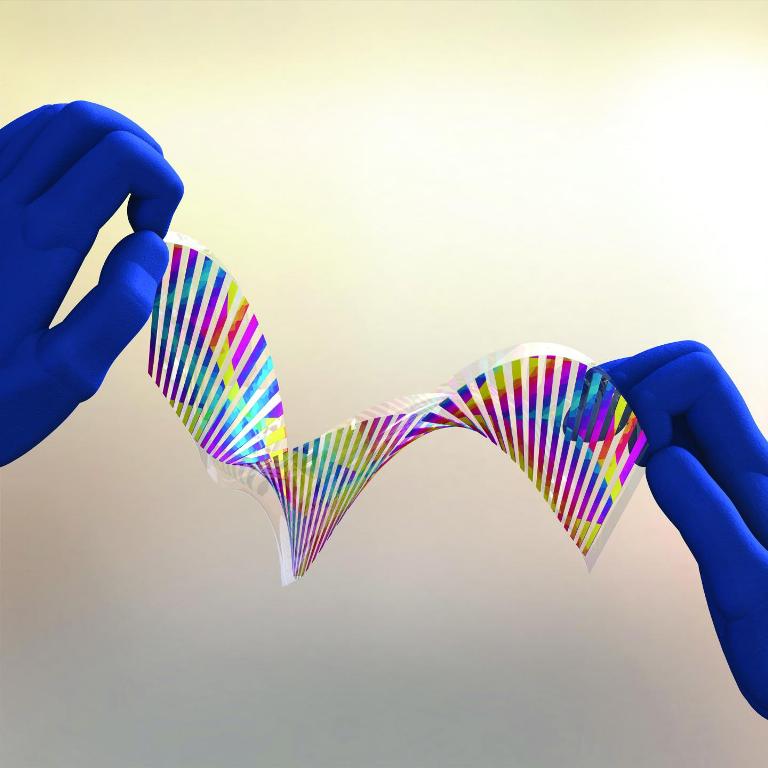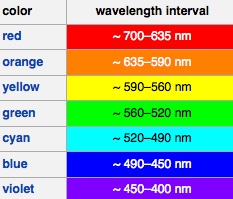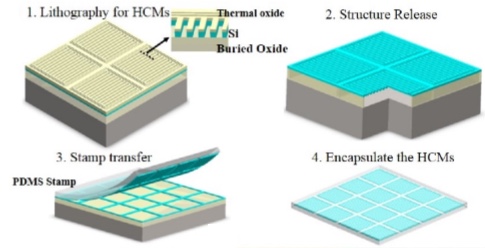Chameleon-like artificial ‘skin’ shifts color on demand
March 13, 2015

This chameleon-like artificial “skin” changes color as a tiny amount of force is applied (credit: The Optical Society/OSA)
Engineers from the University of California at Berkeley have created an incredibly thin, chameleon-like material that can be made to change color on demand by simply flexing it with a tiny amount of force.
This new material-of-many-colors offers intriguing possibilities for an entirely new class of display technologies, color-shifting camouflage, and sensors that can detect otherwise imperceptible defects in buildings, bridges, and aircraft.
The trick: precisely etching tiny features — smaller than a wavelength of light — onto a nanoscale silicon film, allowing the engineers to select the range of colors the material would reflect, depending on how it was flexed and bent.
The colors we typically see in paints, fabrics, and other natural substances occur when white, broad-spectrum light strikes their surfaces. The unique chemical composition of each surface then absorbs various bands, or wavelengths of light. Those that aren’t absorbed are reflected back, with shorter wavelengths giving objects a blue hue and longer wavelengths appearing redder and the entire rainbow of possible combinations in between. Changing the color of a surface, such as the leaves on the trees in autumn, requires a change in chemical make-up.

(credit: Wikimedia Commons)
But rather than controlling the chemical composition of a material, it’s possible to control the surface features at the nanoscale so they interact and reflect particular wavelengths of light. This type of “structural color” is much less common in nature, but is used by some butterflies and beetles to create a particularly iridescent display of color.
This is how evenly spaced slits known as diffraction gratings are routinely used to direct light and spread it into its component colors in astronomy. Efforts to control color with this technique, however, have proved impractical because the optical losses are simply too great.
The engineers applied a similar principle, but with a radically different design, to achieve the color control they were looking for. In place of slits cut into a film, they etched rows of ridges onto a single, thin layer of silicon.
Rather than spreading the light into a complete rainbow, however, these ridges — or bars — reflect a very specific wavelength of light in nanometers (nm). By “tuning” the spaces between the bars, it’s possible to select the specific color to be reflected.
How to create chameleon-like skin
Since the spacing (“period”) of the bars is the key to controlling the color they reflect, the researchers realized it would be possible to subtly shift the period — and therefore the color — by flexing or bending the material.
Earlier efforts to develop a flexible, color shifting surface, such as coatings developed at Harvard covered on KurzweilAI, which reflect only a narrow set of wavelengths, fell short on a number of fronts. Metallic surfaces, which are easy to etch, were inefficient, reflecting only a portion of the light they received. Other surfaces were too thick, limiting their applications, or too rigid, preventing them from being flexed with sufficient control.

Schematic of the major steps for fabrication of the high-contrast metastructure (HCM). Step 1: Etch the silicon metastructure with the thermal oxide as the hard mask (the inset shows the cross section of the etching profile). Step 2: Release the HCMs from the substrate with vapor HF etching. Step 3: Use stamp transfer method to transfer the silicon HCMs to the transparent, flexible polydimethylsiloxane (PDMS) membrane. Step 4: Encapsulate the flexible HCM sample with PDMS. (credit: Li Zhu et al./Optica)
The Berkeley researchers were able to overcome both these hurdles by forming their grating bars using a semiconductor layer of silicon approximately 120 nanometers thick. Its flexibility was imparted by embedding the silicon bars into a flexible layer of silicone. As the silicone was bent or flexed, the period of the grating spacings responded in kind.
The semiconductor material also allowed the team to create a skin that was incredibly thin, perfectly flat, and easy to manufacture with the desired surface properties. This produces materials that reflect precise and very pure colors and that are highly efficient, reflecting up to 83 percent of the incoming light.
Their initial design, subjected to a change in period of a mere 25 nanometers, created brilliant colors that could be shifted from green to yellow, orange, and red — across a 39-nanometer range of wavelengths in the spectrum. Future designs, the researchers believe, could cover a wider range of colors and reflect light with even greater efficiency.
Multiple applications
For this demonstration, the researchers created a one-centimeter square layer of color-shifting silicon. “The next step is to make this larger-scale and there are facilities already that could do so,” said Connie J. Chang-Hasnain, a member of the Berkeley team and co-author on a paper published in Optica, The Optical Society’s (OSA) new high-impact journal. “At that point, we hope to be able to find applications in entertainment, security, and monitoring.”
For consumers, this chameleon material could be used in a new class of display technologies, adding brilliant color presentations to outdoor entertainment venues. It also may be possible to create an active camouflage on the exterior of vehicles that would change color to better match the surrounding environment.
Sensors could also be created that would change color to indicate that structural fatigue was stressing critical components on bridges, buildings, or the wings of airplanes.
The material an also be used for steering a laser beam, with more than 36 resolvable beam spots, suggesting possible new types of displays.
Abstract for Flexible photonic metastructures for tunable coloration
The ability to actively control the perceived color of objects is highly desirable for a variety of applications, such as camouflage, sensing, and displays. We report a completely new flexible high contrast metastructure (HCM) whose color can be varied by stretching the membrane. This is accomplished by annihilating the 0th order diffraction while enhancing the -1st order, a new phenomenon made possible with a large index contrast. The color perception of the HCM can thus be changed by varying its period. The structure is fabricated by using silicon metastructures embedded in a flexible membrane. We experimentally demonstrate brilliant colors and change the color from green to orange (39 nm wavelength change) with a stretch of 25 nm period change. The same effect can be used for steering a laser beam with more than 36 resolvable beam spots being demonstrated.
